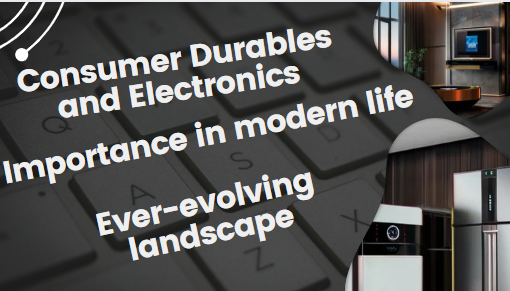The introduction to this discussion highlights the importance of electronics warehouses, exploring their vital role in the supply chain ecosystem. We embark on a journey through the complexities of these dynamic places, highlighting their operations, challenges and constant exploration of adaptation.
- Introduction
- Defining Consumer Durables and Electronics
- Importance in modern life
- Ever-evolving landscape
- Onward journey
- Importance in daily life
- Social Impact
- Early start
- Pioneer electronic age
- Contemporary era
- Types of Consumer Durables
- Warehouse Design and Layout
- Inventory Management Strategies
- Fulfillment and Order Processing
- Technological integration and innovation
- Sustainability Initiative
- Continuous improvement and adaptability
- Conclusion
- Frequently Asked Questions:
- What are consumer durables and electronics?
- How are consumer durables different from consumer non-durable goods?
- Which technological advancements have significantly impacted the consumer electronics industry?
- How do consumer electronics affect the environment?
- What factors should consumers consider when purchasing consumer electronics?
- What are the latest trends in consumer electronics?
- How do manufacturers ensure the safety of consumer electronics?
- What is the life expectancy of consumer durables such as appliances and electronics?
- How can consumers responsibly dispose of old electronics?
- What are the prospects for consumer durables and electronics?
Introduction
In the continuously changing world, few elements like consumer durables and electronics are so complicatedly woven into our daily routines. This vast domain includes a multitude of products that range from essential home appliances to cutting-edge technological devices that fundamentally change the way we live, work, and interact with the world.

Defining Consumer Durables and Electronics
Consumer durables include a broad range of goods designed for long-term use, intended to increase convenience, comfort, and efficiency in homes and businesses. This scope includes essential appliances like refrigerators, washing machines, televisions, and a range of gadgets and devices including smartphones, laptops, and wearable technology.
On the other hand, electronics represent the technological nerve center. It’s an empire of innovation, where extraordinary advancements in hardware, software, and connectivity constantly redefine what’s possible. This segment includes complex circuits of microprocessors, attractive designs of smartphones, extensive experience with home entertainment systems, and the interconnectedness of smart homes.
Importance in modern life
The widespread impact of consumer durables and electronics cannot be underestimated. These products have integrated themselves into the fabric of our lives, becoming essential companions that streamline tasks, entertain, and keep us connected in an increasingly digital world.
From simplifying ordinary tasks with automated devices to developing global connections through prompt communication, these technologies have redefined convenience and connectivity, exceeding geographical barriers and reshaping social mobility.
Ever-evolving landscape
What began as basic machines and basic electronic components has grown into a dynamic and expanding industry, constantly driven by innovation and consumer demands. The evolution from bulky, analog devices to sleek, interconnected gadgets and devices has been a testament to human imagination and technological prowess.
Furthermore, this development is not just about improving convenience; It is also about addressing sustainability concerns, empowering individuals through information access, and increasing productivity in various spheres of life.
Onward journey
As we stand on the point of extraordinary technological advancements, the landscape of consumer durables and electronics is composed for further change. The fusion of artificial intelligence, IoT (Internet of Things), and sustainable practices promises a future where our devices anticipate our needs, our devices communicate seamlessly, and our interactions with technology become more intuitive and eco-friendly.
Importance in daily life
Convenience and convenience:
Consumer goods and electronics have developed daily routines, making tasks more efficient and less wasteful. From the washing company that makes laundry easier to the tech that serves as a hub for communication, entertainment, and railways, these technologies streamline our lives.
Communication and Democrats:
The arrival of technology, laptops, and social media platforms has redefined communication. We recommend that you contact Dialog globally immediately to provide Qualcomm-enabled access for onboarding and coaching.
Entertainment and Holidays:
Home entertainment systems, gaming consoles, and streaming oceans bring immersive experiences to our living rooms. They offer a variety of entertainment options with personal gadgets and relaxation in mind.
Health and Livelihood:
Analytics technology and health tools help monitor devices, track health benefits, and promote overall wellness. They empower people to take responsibility for their health actively.
Social Impact
Economic development and industry development:
Consumer goods and electronics contribute significantly to economic growth. They boost firms, create job opportunities, and fuel the cycle of technological progress, driving innovation.
Reach and Global Popularity:
These creatures have provided access to information, education, and freedom across the land and around the world. They democratize knowledge and opportunities.
Excessive worries and stagnation:
Face interviews related to electronic products and the global impact of the industry. Efforts towards sustainability and eco-friendly students are gaining momentum in these devices.
Social Stipend:
The empathic nature of these remains has changed social partners. They influence how we interact, say different things, and engage in social discussions, fostering cultural environments and behaviors.
Early start
Industrial Revolution (18th to 19th century):
The birth of mechanization and mass production transformed manufacturing processes. The emergence of early consumer durables such as watches, sewing machines, and basic household appliances streamlined household chores.
First wave of electricity and electronics (late 19th to early 20th century):
Thomas Edison’s invention of the electric light bulb in 1879 paved the way for electrical appliances.
The invention of the vacuum tube and radio communication by figures like Marconi transformed communication.

Pioneer electronic age
Rise of consumer electronics (mid-20th century):
World War II promoted technological advancements, leading to the creation of radar and computing machines.
After the war, transistors, invented in 1947, replaced vacuum tubes, making devices smaller, more reliable, and economical.
Television and Home Appliances (1950-1960):
The mass production of televisions brought visual entertainment into homes and became a cultural centerpiece. This era saw the proliferation of home appliances such as refrigerators, washing machines, and vacuum cleaners, which transformed domestic life.
Digital revolution and modern era
Microprocessor and Personal Computing (1970s):
The arrival of microprocessors by Intel in the early 1970s laid the groundwork for personal computers.
Companies like IBM and Apple introduced consumer-friendly computers, transforming work and personal life.
Mobile phones and personal electronics (late 20th century):
The development of mobile phones in the 1980s marked a turning point in communications, eventually leading to smartphones.
Shrinking and digitalization led to the birth of portable music players, digital cameras, and handheld gaming devices.
Contemporary era
Internet and Connectivity (Late 20th Century – Present):
The commercialization of the Internet in the 1990s transformed information access, communications, and commerce.
The arrival of broadband and wireless connectivity has facilitated a more interconnected world.
Smart Devices and IoT (21st Century):
The integration of sensors, connectivity, and AI led to the rise of smart devices and the Internet of Things (IoT).
Smart homes, wearable technology, and interconnected devices marked the era, making greater automation and convenience possible.
Types of Consumer Durables
Home Appliances
Kitchen Equipment:
Refrigerator: Essential for food preservation, available in a variety of sizes and configurations.
Ovens and microwaves: Provide the convenience of cooking and heating food efficiently.
Dishwasher: Automatic dish cleaning, saving time and effort.
Laundry Equipment:
Washing Machines: Simplify laundry tasks, available in top-load, front-load, and fully automatic models.
Dryer: Aids in drying clothes efficiently.
Small appliances:
Vacuum cleaners: Aid in cleaning floors, upholstery, and surfaces.
Coffee Maker, Toaster, Blender: Increase convenience in preparing food and beverages.
Entertainment Electronics
Television:
LED, OLED, and QLED TVs: offer different display technologies and sizes for an immersive viewing experience.
Smart TV: Provide internet connectivity, streaming services, and app integration.
Audio system:
Soundbars, Home Theater Systems: Improve audio experiences for movies, music, and gaming.
Wireless speakers: Provide portability and connectivity options.
gaming consoles:
PlayStation, Xbox, Nintendo: Provide gaming entertainment with advanced graphics and gameplay experiences.
Personal Electronics
Smartphones:
iOS, and Android devices: Enable communications, Internet browsing, photography, and app usage.
Tablet: Large screen for multimedia consumption and productivity.
Wearable Technology:
Smartwatch, Fitness Tracker: Monitor health metrics, and fitness activities and provide connectivity features.
AR/VR headset: Provide immersive experiences in gaming, education, and simulation.
Personal Computer/Laptop:
Desktop PC, laptop, notebook: Act as a workstation, enabling productivity, entertainment, and connectivity.
Heating and cooling equipment
Air conditioner:
Window AC, Split AC: Control indoor temperature for comfort, available in different capacities.
Heater: Space heaters, and radiators: Provide warmth in cold weather.
Miscellaneous consumer durables
Furniture:
Sofa, bed, table: furnishings that contribute to comfort and aesthetics.
Home Security Systems: CCTV cameras, smart locks: Increase security and safety measures at home.
Power tools: Drills, sanders, and saws aid in DIY projects and home repairs.

Warehouse Design and Layout
Storage optimization
Racking systems: Applying high-density storage solutions to accommodate various sizes and shapes of electronic products.
Zoning Strategies: Separating areas based on product type, size, and storage requirements.
Safety and security measures
Fragile Product Management: Special storage and handling protocols for fragile electronic items.
Security protocols: Implementing monitoring, access control, and theft prevention measures.
Inventory Management Strategies
Inventory Management for Diverse Products
Tracking systems: Using barcoding, RFID, or IoT-based systems for accurate inventory tracking.
Just-in-Time (JIT) Inventory: Implementing JIT to manage inventory levels efficiently.
Seasonal demand management
Forecasting and Planning: Predicting and preparing for peak seasons and electronics demand trends.
Buffer Inventory: Maintaining surplus stock during high-demand periods while considering product obsolescence.
Fulfillment and Order Processing
Order picking and packing
Efficient picking methods: Using batch picking, wave picking, or zone picking to speed up order fulfillment.
Quality checking: Verifying the quality and functionality of the product before packaging.
Efficient shipping and delivery
Packaging Protocol: Ensuring safe packaging for safe transportation.
Logistics Coordination: Collaborating with logistics partners for timely and safe delivery.

Technological integration and innovation
Automation and Robotics
Automated Guided Vehicles (AGV): Employing AGVs for the movement of materials within warehouses.
Robotics in Sorting and Selection: Applying Robotic Systems for Faster and More Accurate Order Processing.
Warehouse Management System (WMS)
Real-time tracking: Using a WMS for real-time monitoring of inventory, orders, and workflow.
Data Analytics: Leveraging analytics to optimize inventory levels, space utilization, and operational efficiency.
Sustainability Initiative
Eco-friendly behavior
Energy-efficient systems: implementing LED lighting, energy-saving devices, and renewable energy sources.
Recycling and Waste Management: Establishing recycling programs for electronic waste and packaging materials.
Continuous improvement and adaptability
Scalability and Flexibility
Adapting to technological changes: Being proactive in incorporating new technologies and adapting to market trends.
Continuous Training: To provide continuous training to warehouse employees for skill enhancement and operational efficiency.
Conclusion
Operating consumer durables and electronics warehouses involves the meeting of technological innovation, careful planning, and adaptability to meet the dynamic demands of the market. The integration of advanced technologies, coupled with sustainable practices and streamlined processes, plays a vital role in ensuring efficient management and delivery of these products to consumers across the globe.
Click here for similiar topics.
Frequently Asked Questions:
What are consumer durables and electronics?
Consumer durables refer to products designed for long-term use that enhance daily living, including appliances such as refrigerators, and washing machines, and electronics such as smartphones, TVs, and laptops.
How are consumer durables different from consumer non-durable goods?
Consumer durables are long-lasting products like appliances and electronics that are used for long periods. In contrast, consumer non-durable goods are consumable items for immediate or short-term use, such as groceries or toiletries.
Which technological advancements have significantly impacted the consumer electronics industry?
Technological advancements such as the transistor, the microprocessor, and the invention of the Internet have transformed consumer electronics, leading to the development of smartphones, smart home devices, high-definition displays, and IoT-connected gadgets.
How do consumer electronics affect the environment?
Consumer electronics contribute to electronic waste, creating environmental challenges. Initiatives such as recycling programs and eco-friendly manufacturing aim to reduce the environmental impact of these products.
What factors should consumers consider when purchasing consumer electronics?
Consider aspects such as product specifications, brand reputation, user reviews, after-sales service, warranty, and environmental impact when purchasing consumer electronics.
What are the latest trends in consumer electronics?
Current trends include the rise of smart home technology, wearable devices for health tracking, integration of AI and voice assistants in gadgets, and the development of foldable and high-refresh-rate displays in smartphones.
How do manufacturers ensure the safety of consumer electronics?
Manufacturers comply with safety standards, conduct hard testing, and implement quality control measures to ensure that consumer electronics meet safety requirements before they reach the market.
What is the life expectancy of consumer durables such as appliances and electronics?
The life expectancy of consumer durables varies depending on use, maintenance, and technological advances. Typically, appliances have a lifespan of 5 to 15 years, while given the rapid technological advancements, electronics can last 2 to 7 years.
How can consumers responsibly dispose of old electronics?
Consumers can responsibly dispose of old electronics by participating in electronic waste recycling programs, donating functional devices, or returning them to authorized recycling centers to prevent environmental pollution.
What are the prospects for consumer durables and electronics?
The future promises more sustainable manufacturing practices, increased connectivity through IoT devices, AI-powered personalized experiences, and integration of consumer electronics into daily life.
